Callanan was an early Hamilton County town which was
actually platted.
This settlement was established
before any railroads came to the area, but did not at first have a formal
name. This settlement soon grew enough to extend north accross the
Ellworth township and Lincoln township border.
When the Des Moines and
Minneapolis Railroad finally came north from Des Moines to Ames in
the 1870s, the people settled here wished to be included on this new transportation
roadway. It was determinded that if the people in four townships
in Hamilton County taxed themselves 5%, they might successfully use the
money to invite the railroad company to build north to this area.
Although this settlement did not yet have a name or title, they had discovered
that a Mr. Callanan was the primary investor of the railroad.
This discovery convinced them to adopt "Callanan" to be their community's
name, so that the railroad would come there. The newer portion
of the settlement became known as "North Callanan."
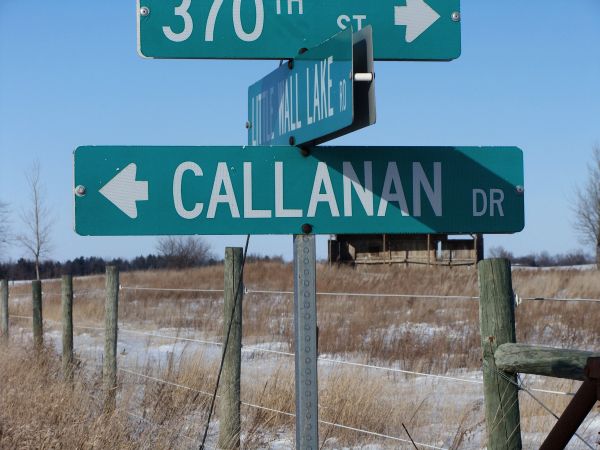
|
| Typical of many road signs in Hamilton
County, this sign on Highway 69 doesn't really indicate the way to Hamilton
County's early settlement called Callanan. But it does indicate the
Callanan existed, and is important to the history of Hamilton County.
This sign is located four
miles south of Jewell on Highway 69. It points west. To really
point towards Callanan, this sign would need to be relocated four miles
north and two miles east. At that point, one mile directly south
of Ellsworth, the sign would point towards Callanan, formerly located one
mile in the direction (west) of the sign.
Lakine's Grove, Ellsworth, Callanan and North Callanan can be seen on the
following map. |
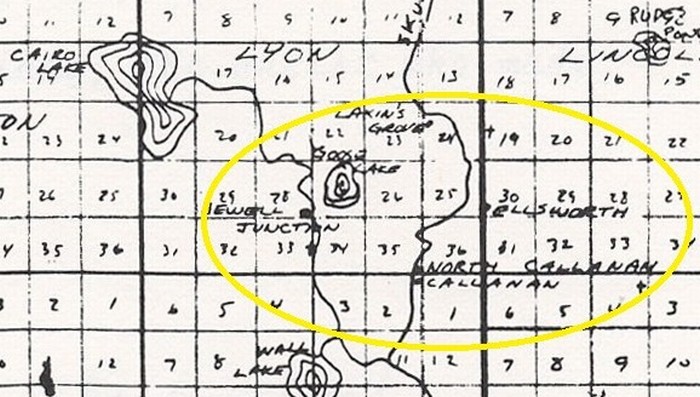
|
| |
The Des Moines and Minneapolis
Railroad worked to finish their construction north of Ames and through
Gilbert, Story City, and Randall. And because 5% of the income of
the settlers in this area would be awarded to the railroad, they
decided to follow the restriction for the money (construct the railroad
to the corner of these four townships in southeast Hamilton County).
The railroad needed to turn a bit East and cross the Skunk River.
The track needed to go up a hill into "town".
This settlement was actually
platted. (View the map at the bottom of this page.) The part
lying in Ellsworth Township was platted in 1878. The addition known
as "North Callanan" was laid out in January, 1879. The town started
with a great flourish and stores were doing a good business and a newspaper
was being printed. The settlement grew and prospered until almost
1880. Callanan became the "town" that was known as the northern terminus
of the narrow gauge line up from Ames and Des Moines.

Lincoln Township of Hamilton County
Some six miles from the southern boundary, a branch
of the Chicago and Northwestern railroad crosses the township from east
to west; the building of this road caused a great change in the history
of the community, since it caused the decay of the already established
town of "Callanan."
A narrow guage railroad had been built from Ames
up to the north line of Ellsworth township, and a station was necessary,
so Callanan was started; it was platten in two sections. The part
lying in Ellsworth township was platted in 1878, and the addition known
as "North Callanan" was within the bounds of Lyon township, and was laid
out in January, 1879. The town started with a great flourish and
stores were doing a good business and a newspaper was being printed, and
all bade fair to growth and prosperity until 1880.
At that time the Northwestern road came through
and the narrow gauge road lost out, the startion was started at Ellsworth
and another at Jewell, and the business people and inhabitants of Callanan
moved their goods and houses either to Ellsworth or to Jewell. So
Callanan became one of our "Ghost Towns."
|
Callanan
Callanan was located in NW Sec 2-86-24 of Ellsworth
Township. An addition, called North Callanan, was located just north across
the township line in SE Sec 35-87-24 in Lyon Township. The two towns were
considered as one for its brief, but violent, history. The people who lived
here in four townships in the southeast corner of our county wanted a railroad,
so they voted themselves a 5% tax to secure one. James Callanan, a Des
Moines investor, was president of the Des Moines and Minnesota Railroad.
His railroad was a narrow gauge line that connected Ames with Des Moines.
He planned to expand it north to Minneapolis. The town of Callanan became
the northern terminus of this expansion.
The town was originally planned to have the name
Lakin, for an early pioneer, but to secure the railroad, the settlers instead
named it Callanan. A post office was secured on April 10, 1878, with David
Schoonmaker as the first postmaster. The town plat was not recorded until
June, with North Callanan being recorded in January, 1879. The postmaster
held up the mail, designated for Lakin's Grove, to increase the count for
Callanan.
The town's violent history came about because it
became a popular spot for rowdy folk from Des Moines to go for a happy
weekend trip. The Callanan Hotel was busy; the many taverns made the liquor
flow freely at all times. When sober residents objected, they were told
that the business was good for Callanan. The town grew to have a population
of about 200.
The railroad went bankrupt and the roadbed was taken
over by the Toledo & Northwestern Railroad. The tracks were then converted
to standard gauge, and the line was relocated to run to Jewell Junction,
connecting with Ellsworth. Most of the town businesses moved to either
Ellsworth or Jewell Junction. The Callanan town depot became the Ellsworth
depot. The Callanan post office was closed on October 12, 1881.
The text above is from: https://sites.google.com/site/hamiltoncountyhistory/home/ghost-towns/callanan
|

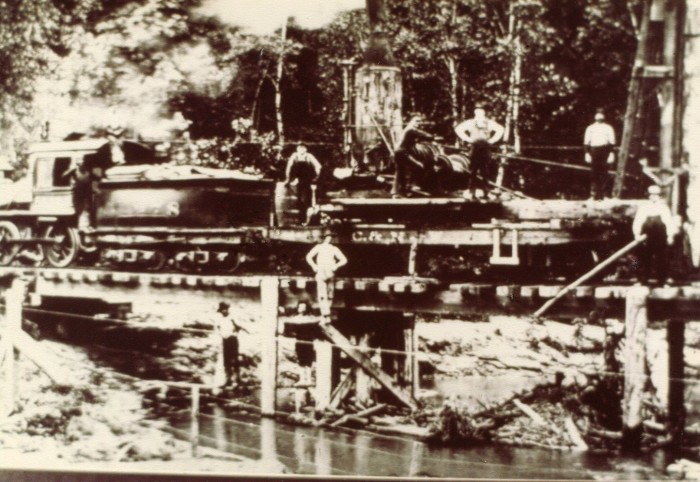
In 1880, the narrow
gauge railroad, the Des Moines and Minneapolis, was bought out by
the Chicago and Northwestrn Railroad and converted the rails to standard
gauge. At that time it no longer crossed the Skunk River, passed
by Callanan and went instead to Jewell. In 1880 and 1881, stations
were started at Ellsworth and Jewell, so Callanan was abandoned.
The businesses and inhabitants of Callanan moved their goods and houses
either to Ellsworth or Jewell. Callanan was then lost.
Here are the plat maps showing Callanan and North Callanan.
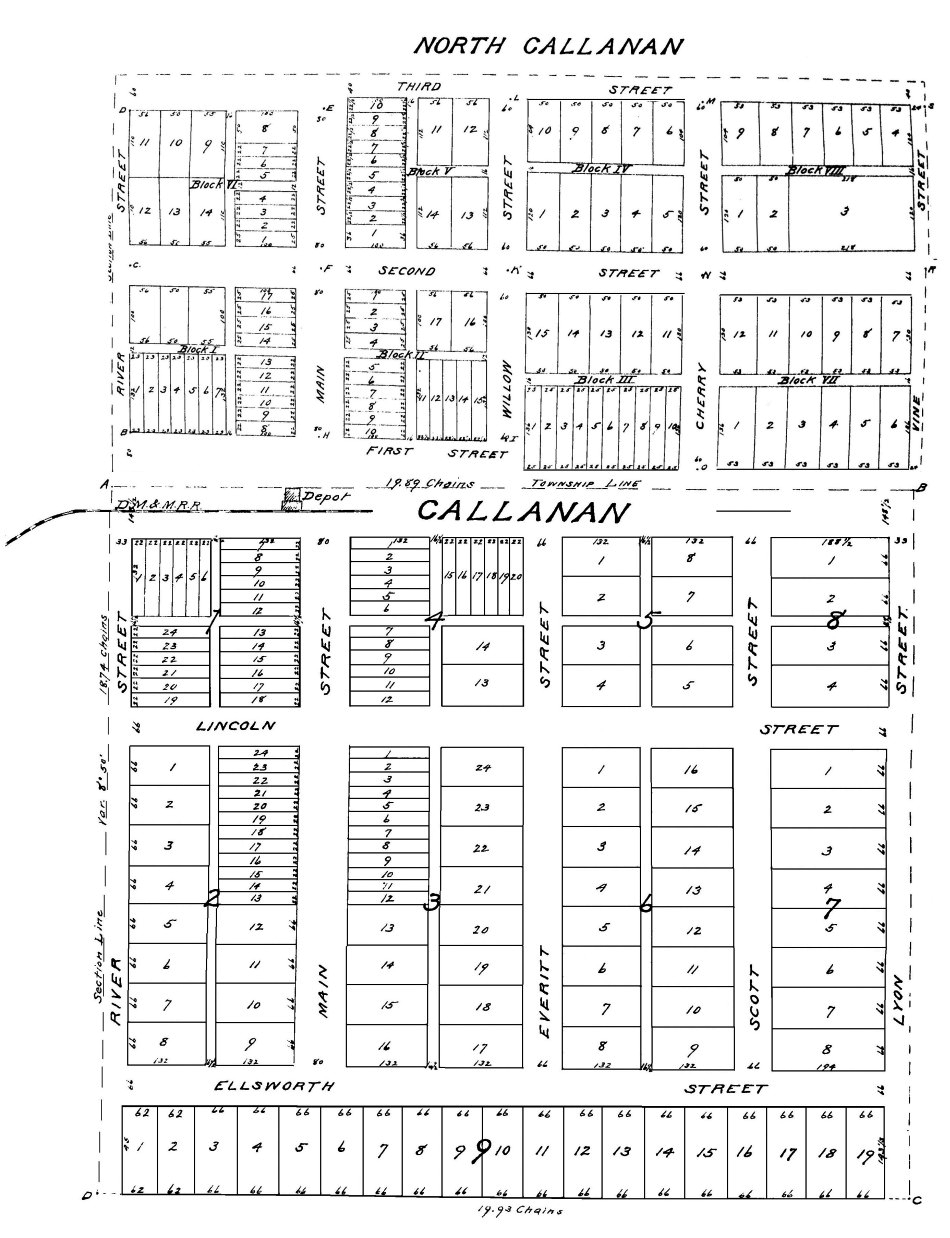
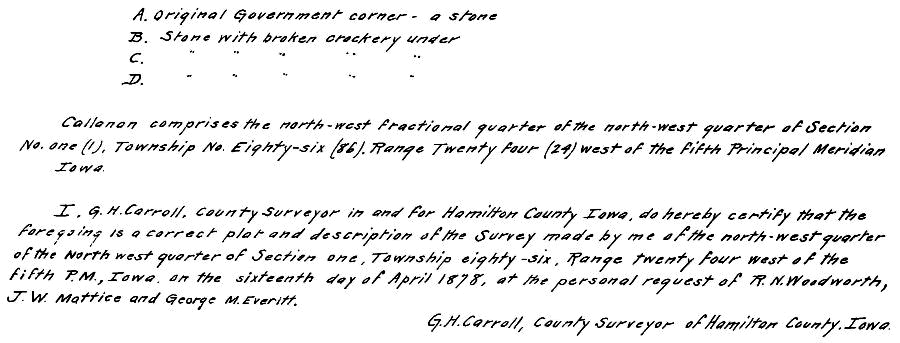
| I,
G. H. Carroll, County Surveyor in and for the Hamilton County Iowa, do
hereby certify that the foregoing is a correct plat and description of
the Survey made by me of the north-west quarter of the Northwest quarter
of Section one, Township eighty-six, Range twenty four west of the fifth
P.M., Iowa on the sexteenth day of April 1878, at the personal request
of R. N. Woodworth, J.W. Mattice and George M. Everitt.
G. H. Carroll, County Surveyor of Hamilton County,
Iowa
(signed)
|
A two-story railroad depot was constructed
in Callanan.
Below, see the enlarged portion of the above plat
map of Callanan, showing where the depot was located.

(Read more about this Callanan story on the following three
pages exploring the settlement of Callanan.)

It is said that Callanan,
the northern terminus of the narrow gauge railroad, was a boom town that
had a fast and furious life of less than three years. It was built
on a high bluff in a beautiful wooded area, east of the Skunk River.
It numbered about 200 residents, and they included physicians, surgeons,
contractors, builders, attorneys, three painters, and a notary public.
There was a boarding house, a hardware store, a drug store, a dry goods
store, a pool hall, and barber shop. There was a Callanan Brick Company,
a blacksmith, a carriage shop, a wagon shop, a meat market, and a boot
and shoe maker.
The settlement became the
scene of many wild parties with liquor available both day and night.
Law enforcement was ineffective and drunken brawls were frequent.
Two murders were committed on the streets of Callanan during its short
existence.
Callanan survived for about
three years following the arrival of the railroad, but after the narrow
guage was converted to standard guage, it no longer crossed the Skunk River
to get into Callanan, but instead turned a bit west and headed northward
to Jewell Junction. The railway company then constructed an east-west
track which became instrumental in a brand new (1880) community known as
Ellsworth. When the railroad left the community of Callanan,
the depot was then moved (during the winter season) to Ellsworth.
In that way, the Callanan depot became the depot for the community of Ellsworth.
After the railroad left Callanan,
the settlement died off as residents moved to either the nearby Ellsworth
or to Jewell. Three houses today in Ellsworth were also moved from
Callanan.
Next Callanan Page (2)
Back Home
|

